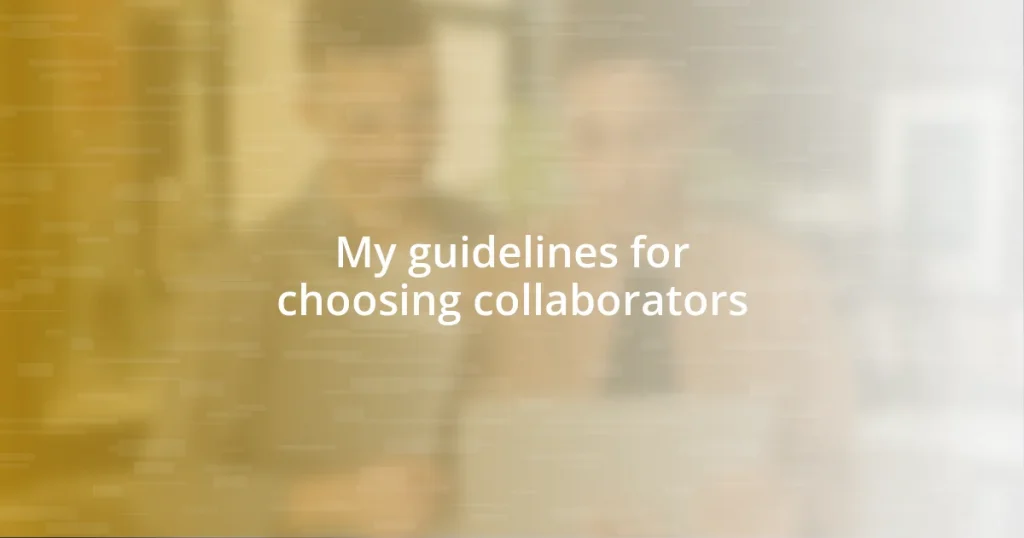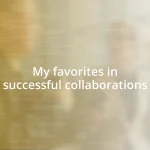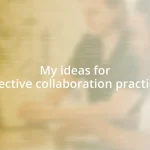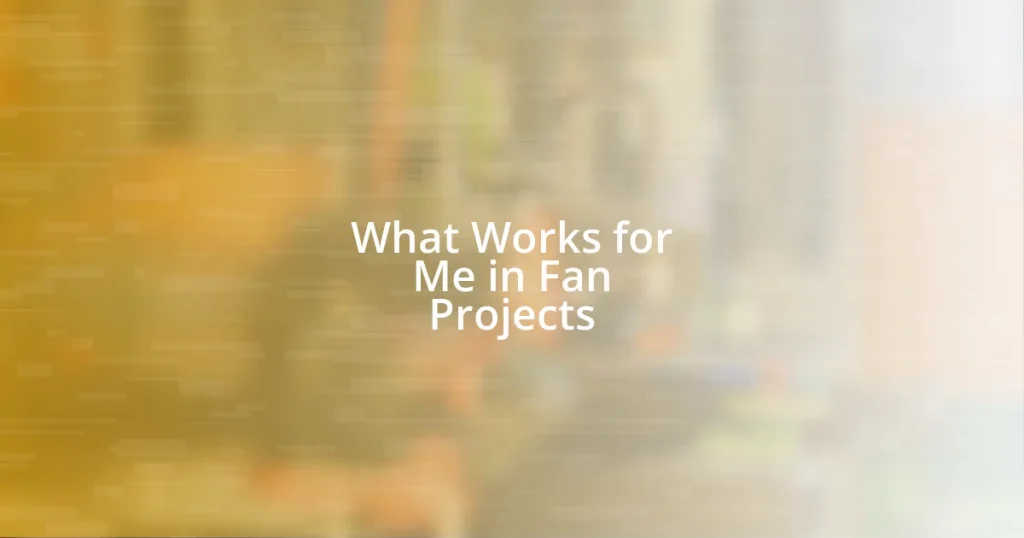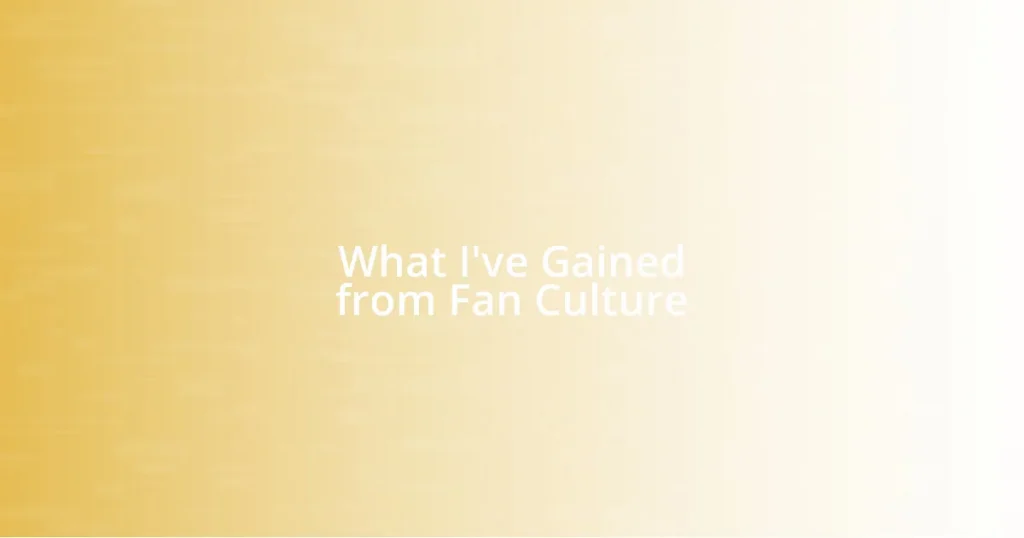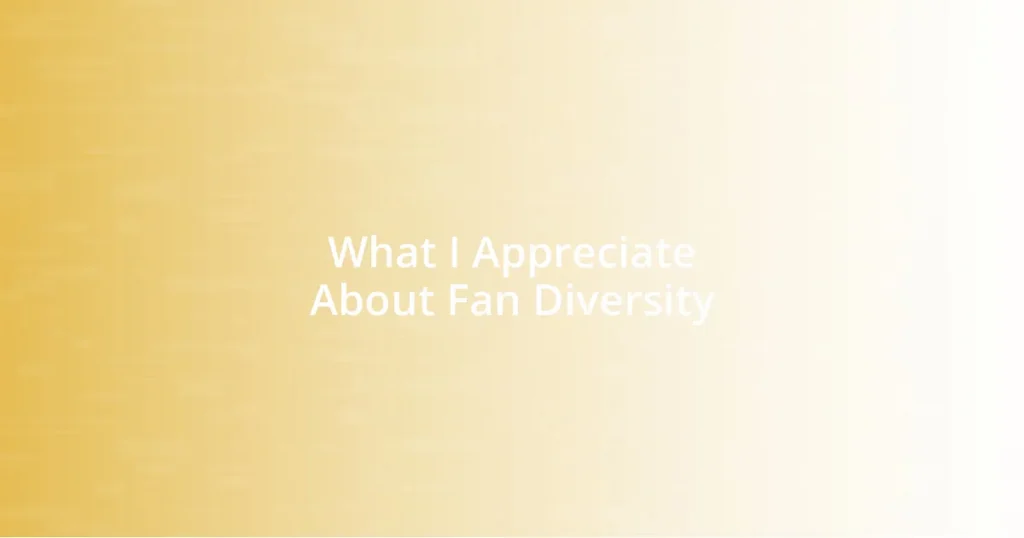Key takeaways:
- Collaboration combines diverse skill sets, enhancing creativity and fostering a supportive environment that transforms challenges into manageable tasks.
- Identifying specific needs and assessing potential collaborators’ skills, communication styles, and past work are crucial for successful partnerships.
- Establishing clear expectations, maintaining open communication, and celebrating successes contribute to a positive and productive collaborative working environment.
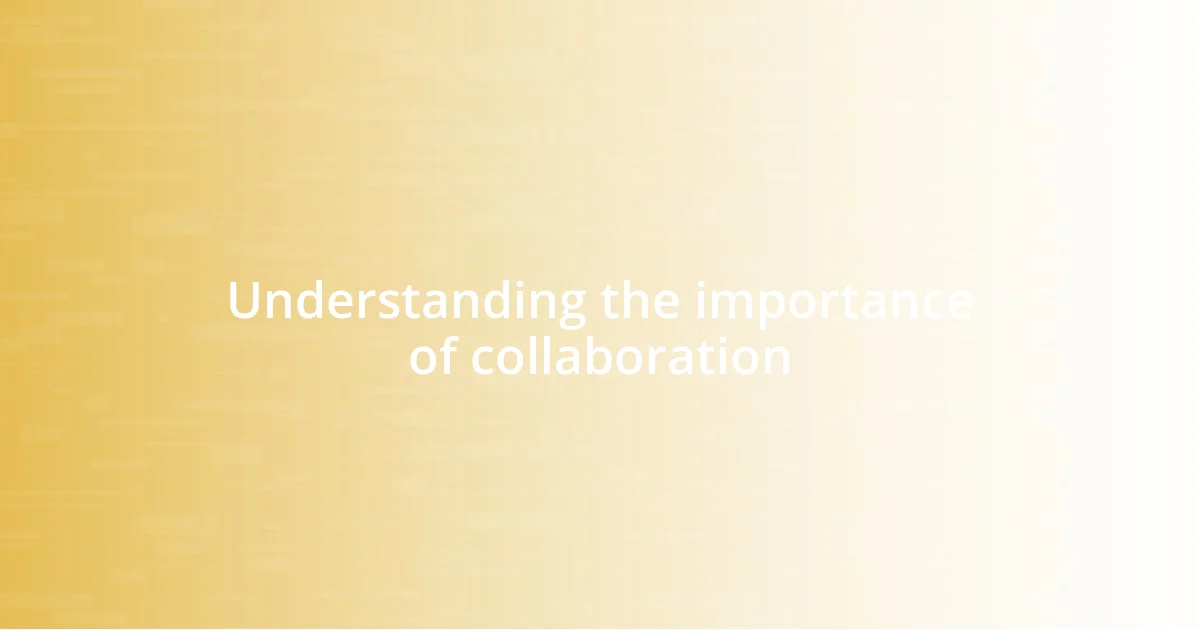
Understanding the importance of collaboration
Collaboration truly transforms the way we approach challenges. I remember a project where my team and I combined our diverse skill sets, leading to innovative solutions that I never would have imagined on my own. Isn’t it fascinating how different perspectives can illuminate new paths we hadn’t considered?
When we come together, we not only pool resources but also create a support system that fosters growth. There’s something uplifting about knowing that others have your back, especially during tough times. Have you ever experienced a moment where teamwork turned a daunting task into a manageable one? That feeling of shared accomplishment is what makes collaboration so powerful.
Moreover, collaboration enhances creativity and encourages open-mindedness. I’ve found that the synergy created when multiple minds work together often sparks ideas in unexpected ways. It makes me wonder: what breakthroughs might we achieve if we continue to embrace the collective strength of collaboration?
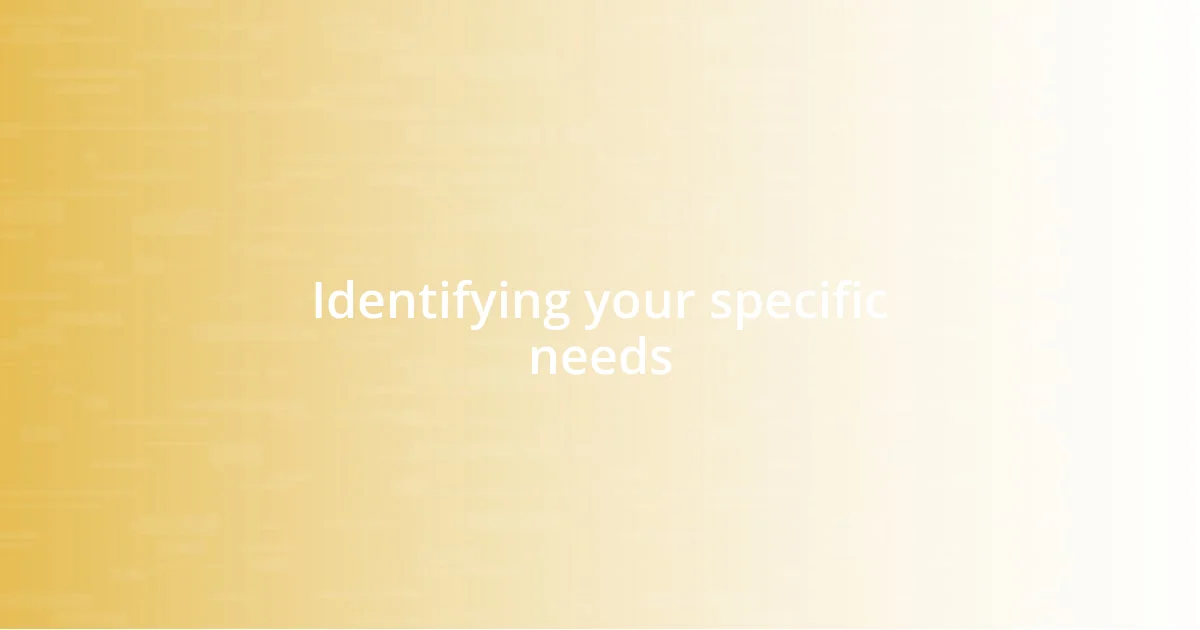
Identifying your specific needs
To effectively identify your specific needs, it’s crucial to reflect on your goals and expectations. When I was starting a new project, I took the time to outline what I needed from collaborators, such as skills, experience, and availability. This exercise not only clarified my vision but also helped me communicate my needs clearly to potential partners.
Asking yourself targeted questions can significantly streamline this process. For instance, I once asked, “What roles are essential for this project?” This question guided me in pinpointing the necessary expertise and even illuminated some gaps in my own knowledge. Often, the act of questioning can reveal insights that help tailor your collaboration needs more closely.
Finally, it’s important to consider your team dynamics and personal working styles. I recall launching a group project where knowing my team’s preferences and strengths was a game-changer. Understanding how each person collaborates and communicates made it easier to assign roles that capitalized on our strengths, ensuring a smoother workflow and fostering a positive atmosphere.
| Considerations | Questions to Ask |
|---|---|
| Skills | What expertise do I need? |
| Experience | How much experience is required? |
| Availability | Are the collaborators available when needed? |
| Team Dynamics | What working styles complement each other? |

Evaluating potential collaborators’ skills
When evaluating potential collaborators’ skills, I think it’s essential to look for a balance between their technical abilities and interpersonal qualities. I remember a time when I partnered with someone whose expertise was undeniable, but their communication style clashed with the team dynamics. It taught me that while skills are important, how someone interacts and collaborates can make or break a project.
Here are key skills to assess in potential collaborators:
- Technical Expertise: Do they possess the necessary knowledge for the specific tasks?
- Problem-Solving Ability: How do they approach challenges? Are they resourceful?
- Communication Skills: Can they articulate ideas clearly and actively listen?
- Adaptability: Are they flexible enough to pivot when needed?
- Team Collaboration: How well do they work with others? Do they foster a positive environment?
On the other hand, it’s also about understanding how their skill set complements yours. In one collaboration, I paired with someone who had a completely different background, which filled gaps I didn’t realize I had. This cross-pollination of skills led to amazing outcomes, reminding me that diversity of expertise can significantly enhance our collective performance. By evaluating both hard and soft skills, I can ensure that my chosen collaborators not only bring valuable knowledge but also create a complementary working synergy.
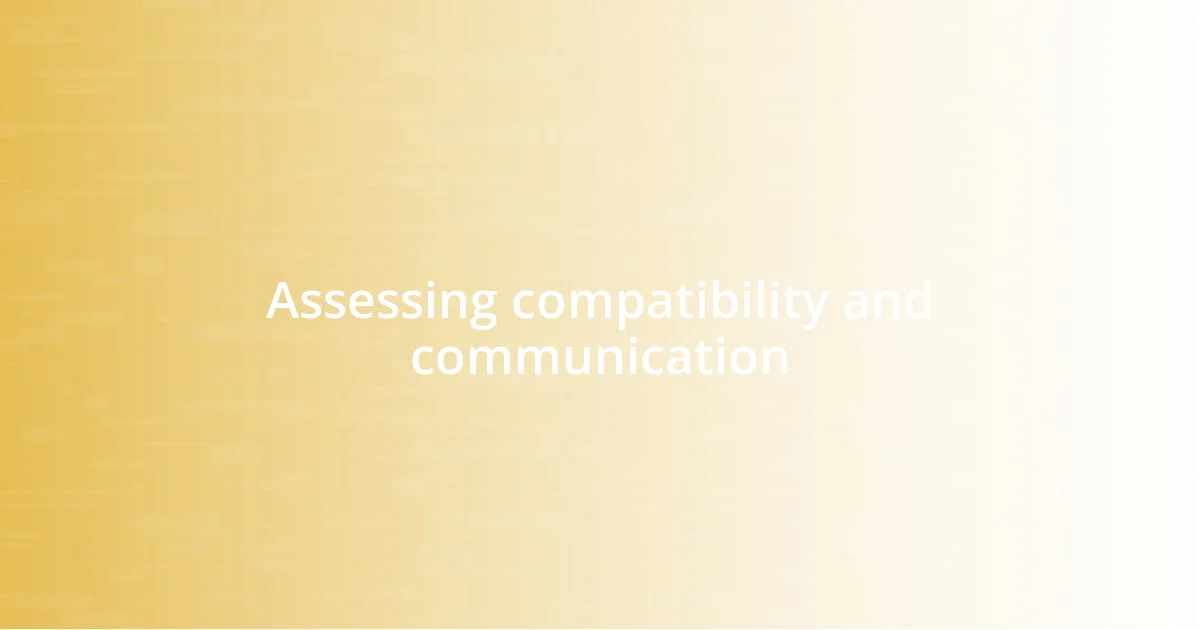
Assessing compatibility and communication
When I think about compatibility and communication, I realize just how critical these elements are in collaboration. It’s not merely about aligning skills; it’s about ensuring that the way we communicate complements our personalities. For instance, I once teamed up with someone whose directness felt refreshing but overwhelming at times. I learned that discussing our preferred communication styles upfront created a comfortable space, making it easier for us to express ourselves without misunderstanding. Have you ever had a collaboration go sideways because of miscommunication? I certainly have, and it taught me that compatibility aids clarity.
Open lines of communication should be established early on. In my experience, I always make it a point to engage potential collaborators in an informal chat before diving into any projects. This not only helps gauge our interpersonal vibes but also reveals how we approach problem-solving. During one such initial conversation, I discovered that a candidate had a penchant for brainstorming ideas aloud—something I thrive on! It led to an effortless exchange of thoughts and creative ideas. Do you think checking communication styles could enhance your collaborative ventures? Well, I’ve witnessed how it can set the groundwork for effective teamwork.
Trust is a cornerstone of compatibility. I remember collaborating with a talented individual, but our lack of trust in each other’s methods created friction. I quickly realized that we needed to share more about our work processes. Simply discussing our expectations and walking through our individual workflows made us feel more secure. As a result, we built a strong foundation for trust, which ultimately bolstered our collaboration. When assessing compatibility, I always ask, “Can we trust and support each other through challenges?” After all, trust can transform how we navigate obstacles together.
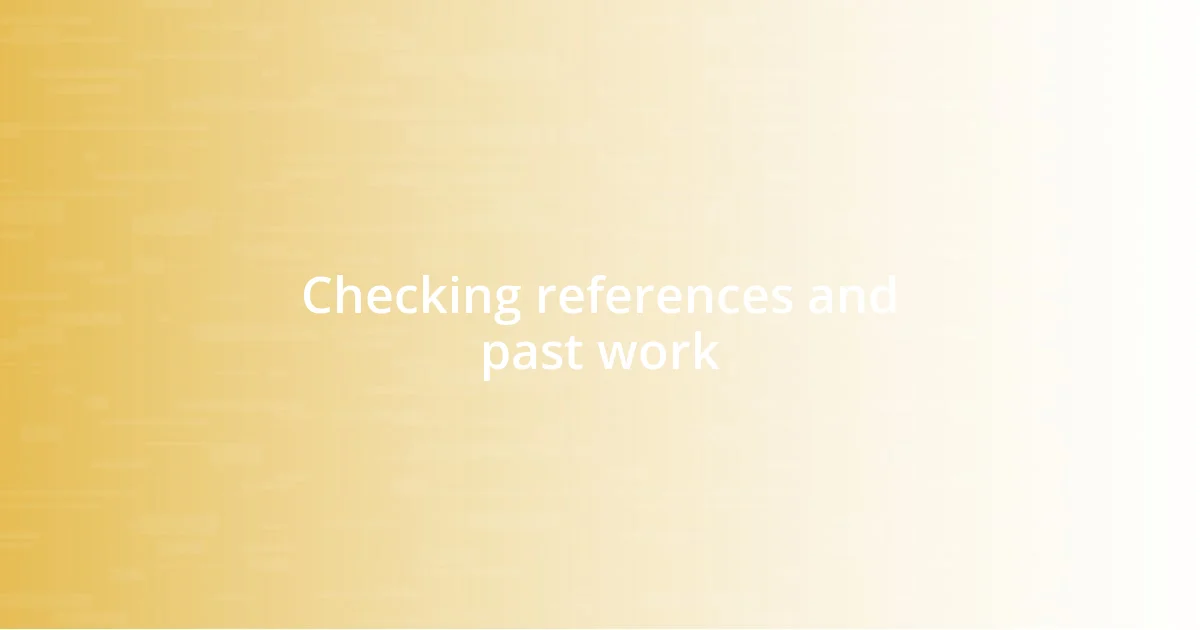
Checking references and past work
When I begin checking references and past work, I find that digging into a collaborator’s history can unveil a lot about their reliability and expertise. I remember a project where I reached out to previous clients of a designer I was considering. Their feedback not only highlighted the designer’s skills but also illuminated their work ethic and how they handle feedback—a critical aspect I believe is often overlooked. Isn’t it fascinating how a simple conversation can paint a clearer picture of someone’s professional character?
I’ve also learned the importance of reviewing a potential collaborator’s portfolio. One time, I overlooked this step and ended up working with someone whose style didn’t align with my vision. Had I taken the time to assess their previous work closely, I would have noticed the disconnect sooner. This experience taught me to always seek out examples that showcase diversity in their projects. I now ask myself: “Does their past work resonate with the kind of project we want to create together?”
Additionally, asking the right questions during reference checks can be tremendously insightful. I often inquire about how the collaborator handles challenges and collaborates under pressure. During one reference call, I learned that the collaborator in question had a knack for transforming conflict into constructive feedback, which convinced me they would enhance our team dynamics. Reflecting on these conversations reminds me that references are not just a box to tick; they hold the keys to understanding how someone truly operates in a collaborative environment.
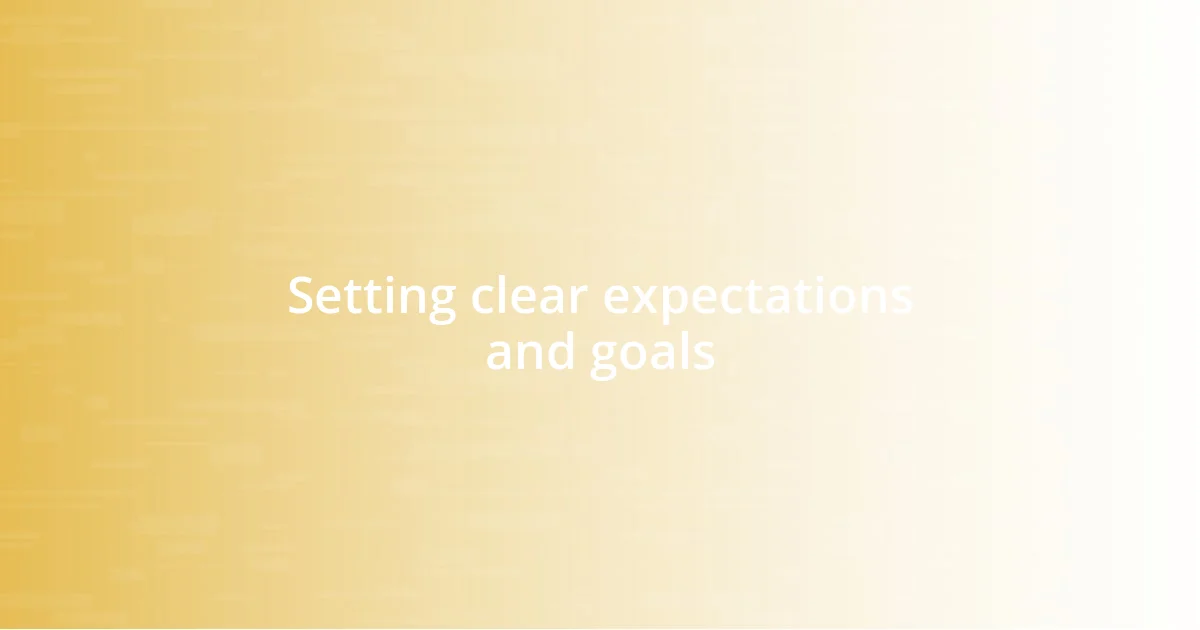
Setting clear expectations and goals
When setting clear expectations and goals, I find that specificity is essential. I once embarked on a project where my collaborator and I had different visions of success. During our early discussions, I proposed we outline measurable objectives together, which transformed our abstract ideas into a concrete plan. This shift not only clarified what we aimed to achieve but also fostered a shared sense of ownership. Have you ever felt lost in a project because everyone was heading in a different direction? Defining those goals up front is a game-changer.
I also believe that documenting our expectations can prevent confusion down the line. In a previous collaboration, we made the mistake of keeping things verbal, leading to misunderstandings regarding deadlines. After that experience, we agreed to write everything down in a project brief—the goals, timelines, and even preferred communication times. I still remember the relief it brought to our workflow. This simple document acted like our guiding star, ensuring we remained aligned. Have you considered how valuable a clear roadmap can be for your team?
Regular check-ins are another pivotal aspect of maintaining clarity in our goals. I learned this during a project that struggled to meet milestones due to lack of communication. We decided to hold weekly meetings to assess our progress and adjust our strategies as needed. Surprisingly, these touchpoints transformed our collaboration—what once felt like a juggling act became a well-coordinated dance. I often ask myself: “How can we create an open dialogue that embraces spontaneity while staying focused on our ultimate goal?” It’s through these ongoing conversations that we truly refine our efforts and achieve success together.
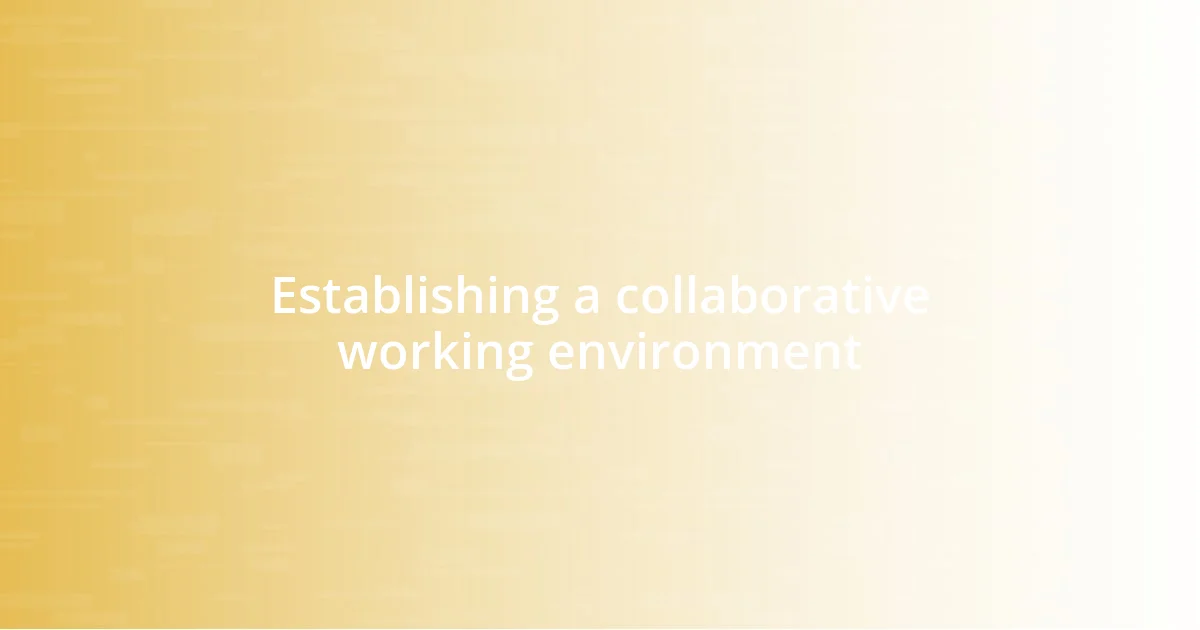
Establishing a collaborative working environment
Creating a collaborative working environment begins with fostering trust among team members. I remember a project where initial hesitations clouded our interactions. To break the ice, I organized a casual brainstorming session where everyone could share ideas without fear of criticism. Watching my colleagues’ faces light up as they expressed themselves reminded me how essential a safe space is for creativity to thrive. Have you ever experienced the ease of collaboration when trust is firmly established? It’s transformative.
Encouraging open communication plays a critical role, too. During one collaboration, I noticed that some team members hesitated to share their concerns. To address this, I initiated an anonymous feedback channel where everyone could voice their opinions freely. The resulting engagement surprised me; suddenly, I found perspectives and ideas that had been hidden before. This approach not only deepened our connections but also illustrated that sometimes, we need to remove barriers to truly unlock team potential.
Equally important is celebrating successes, both big and small. In a recent project, we took the time to acknowledge individual contributions during our meetings. I found that these moments of recognition not only boosted morale but also intensified our commitment to the project’s success. How often do we pause to appreciate the journey instead of just focusing on the end goal? Taking a moment to celebrate creates a vibrant energy that fuels future collaboration and resilience against challenges.










